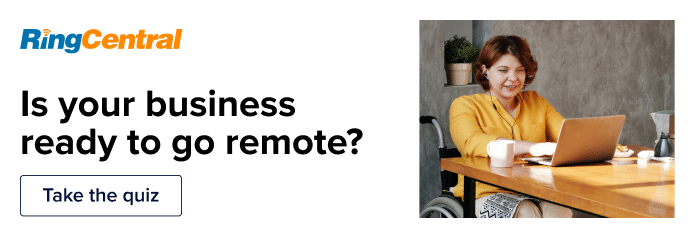Think about all the ways that customers and potential customers read about your business. As a small business owner, you’re in luck—you have lots of control over the flow of information.
You’re in charge of how and where you advertise, what you choose to say, and what message you want to convey. This is your messaging strategy.
In this post, we’ll look at:
- What a messaging strategy is
- The 4 essential elements of a messaging strategy
- The benefits of a messaging strategy
- 4 real-life examples of messaging strategies
- How to create your own messaging strategy
Shopping for a team messaging tool? (Or just curious about what to look for?) Grab the free checklist to help you choose the right one for your team or business.
What is a messaging strategy?
A messaging strategy is the key to successfully marketing your business. It’s how you position yourself, it’s your communication methods, and it influences every bit of text connected to your business, from in-store signage and advertising to customer support emails and web copy.
Your messaging strategy helps you build brand awareness and informs your customers about who you are as a business—and it just might be a deciding factor in whether or not they choose to support you. So it’s important to construct it with care: think about your overarching message, how you want to market yourself, and how you want to develop your messaging over time.
4 essential elements of a messaging strategy
When you first start building your messaging strategy, there will be lots to consider. Don’t get overwhelmed—start with the essentials and go from there. Here are four topics to think about from the get-go.
1. Distinguishing factors
What sets your business apart? Think about the factors that distinguish you, and focus on them.
If you’re having trouble, try to think about this from the perspective of your customers. Why should they come to your business instead of your competitors? What do you offer that makes you unique?
It could be your impeccable customer service, your ethical business practices, your high-quality products—the list is endless, since every company is different.
Here’s a quick example: M&Ms. Since 1949, their slogan has been “Melts in your mouth, not your hand.”
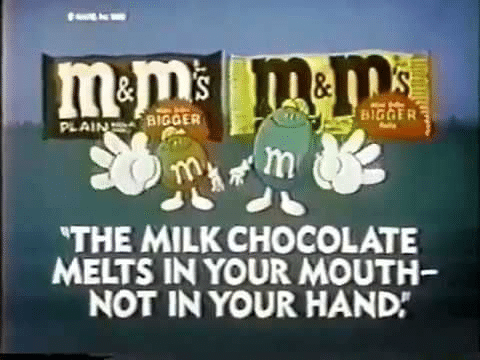
Even though it’s a little long for a slogan, it’s recognizable and relatable. M&Ms were born of the desire to eat chocolate in hot climates without it melting, so the unique selling point followed naturally. Nobody likes eating messy melted chocolate unless it’s in s’mores.
Without a unique selling point, a messaging strategy isn’t likely to be effective. Clarify your distinguishing factors and make them a key part of your brand.
2. A stated goal
What do you want to accomplish with your business? And how do you want to convey that to your customers?
“Generate profit” probably won’t cut it as a meaningful marketing objective, unless your product is related to investments. Today’s consumers are more globally conscious than ever, so they’re drawn to companies with a purpose. When your customers understand your purpose and are drawn to it, it’ll ultimately benefit both them and your business.
Mozilla Firefox, for example, is the world’s third most popular internet browser and has managed to retain this position despite its lack of backing from any major technology corporation. (For reference, Google Chrome is number one, and Apple’s Safari is number two.)
Mozilla’s company goals are clearly laid out on their website: “… to ensure the Internet is a global public resource, open and accessible to all… where individuals can shape their own experience and are empowered, safe and independent.”
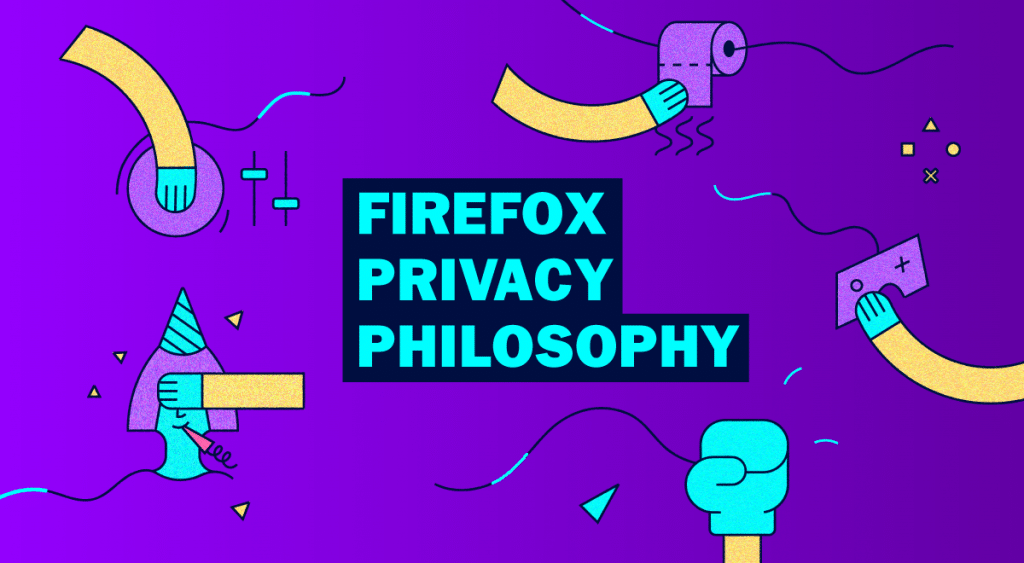
Mozilla has written extensively on online privacy and its importance as part of their good “Internet Citizen” philosophy.
Mozilla’s emphasis on privacy and security has garnered them a devoted following: it’s a goal that both boosts employee engagement and gives users something to believe in. Having a good marketing report can help you get an accurate view of whether you’re hitting your marketing goals.
3. An understanding of your target audience
Just as your customers need to understand your goal, you need to understand your customers. Finding out as much as you can will help you to refine your messaging strategy so that it speaks to the customers you want to reach.
Defining a target audience can be tricky. But don’t start too big—if your target is too broad, it may be hard to craft an effective messaging strategy.
Tesla is a good example of a company that started with a narrow target market. Their earliest vehicle, the Tesla Roadster, was the first of its kind: a highway-legal mass-produced electric car.

The 2008 Tesla Roadster, the first mass-produced fully electric car.

The 2019 Tesla Model 3, currently the top-selling electric car worldwide.
The Roadster, which was first delivered to customers in 2008 and ceased production in 2012, wasn’t cheap. Tesla targeted wealthy individuals with a green mindset, who wanted to drive an electric car with a luxury feel. As Tesla’s fame grew, its target audience expanded, and it began to produce more affordable electric cars—which had been its plan all along.
By understanding its customers, Tesla was able to grow its business exponentially, and its vehicles, such as the more affordable Model 3, are now the top-selling electric cars worldwide.
4. A compelling story
You have a reason for starting your business, so talk about it. The story behind a company can help customers form an emotional connection with it.
Your story should form a key part of your messaging strategy—it’s where you came from, what you’re doing, and where you want to go. Making your business feel personal is a great way to resonate with your target audience.
Good stories create feelings. Toms Shoes, for example, tells the story of their company’s founder, who traveled to Argentina in 2006. While there, he witnessed intense poverty, and a key facet of this was the lack of shoes.
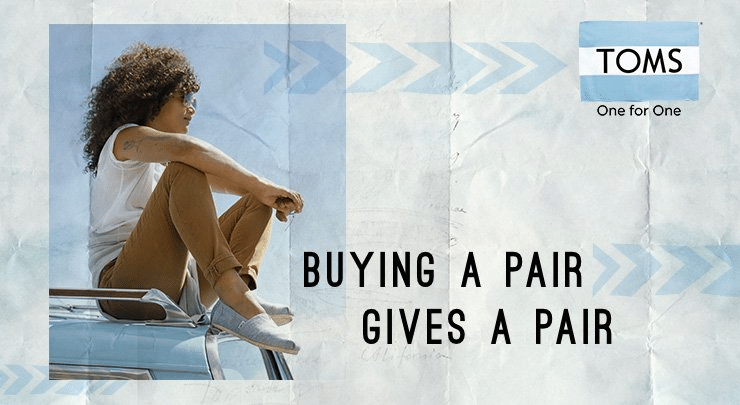
A Toms Shoes ad that showcases their donation policy.
This inspired him “to create a for-profit business that was sustainable and not reliant on donations.” Over the years, this story has remained a central pillar of the company’s messaging strategy. Toms Shoes donates one pair of shoes for every pair sold, and their current donation numbers stand at over 88 million pairs.
The benefits of a messaging strategy
From the elements discussed above, you should already see the power of a good messaging strategy. Marketing yourself without a unified strategy could end up alienating potential customers: they might end up confused about the purpose of your brand. At worst, you could be seen as incoherent. But the impact of a good and cohesive strategy will go beyond what we’ve already talked about to empower all aspects of your business.
When you’re creating marketing materials, whether they’re emails, signs, coupons, or something else, your messaging strategy will guide you towards what to focus on and what tone of voice to use. If you’re writing blog articles or planning a social media campaign, you’ll know how to speak to your customers in a way that catches their attention.
A good messaging strategy also helps with customer service teamwork. Educating customers using consistent language is easier when you can speak to them in a way that you know they’ll understand.
And, just as importantly, it will help you outside the workplace. Imagine yourself at a dinner party. You’re witnessing an interaction between two strangers who are getting to know each other. One says something like, “So what do you do for work?” The other person reacts in one of two ways:
- They smile or laugh awkwardly and launch into a long-winded explanation that loses the interest of whoever’s listening.
- They give a short and concise explanation, so the conversation can either continue or change topics.
Which would you rather be? As a small business owner, you’re representing your business at all times. So whenever questions like, “What do you do?” come up, you’ll know exactly what to say and how to explain it.
4 examples of unique messaging strategies
Here are some real-world examples of brand and marketing messaging examples, from slogans and campaigns to digital strategies.
1. Nike
Industry: Sports apparel and equipment
Location: Worldwide
Messaging strategy: Spark a desire to exercise in customers of all fitness levels, from first-timers to serious athletes
Nike’s messaging is tough, straightforward, and motivational without being pandering. Their most famous campaign of all time, which first launched in 1988, created one of the most recognizable retail slogans out there. Maybe you know it?
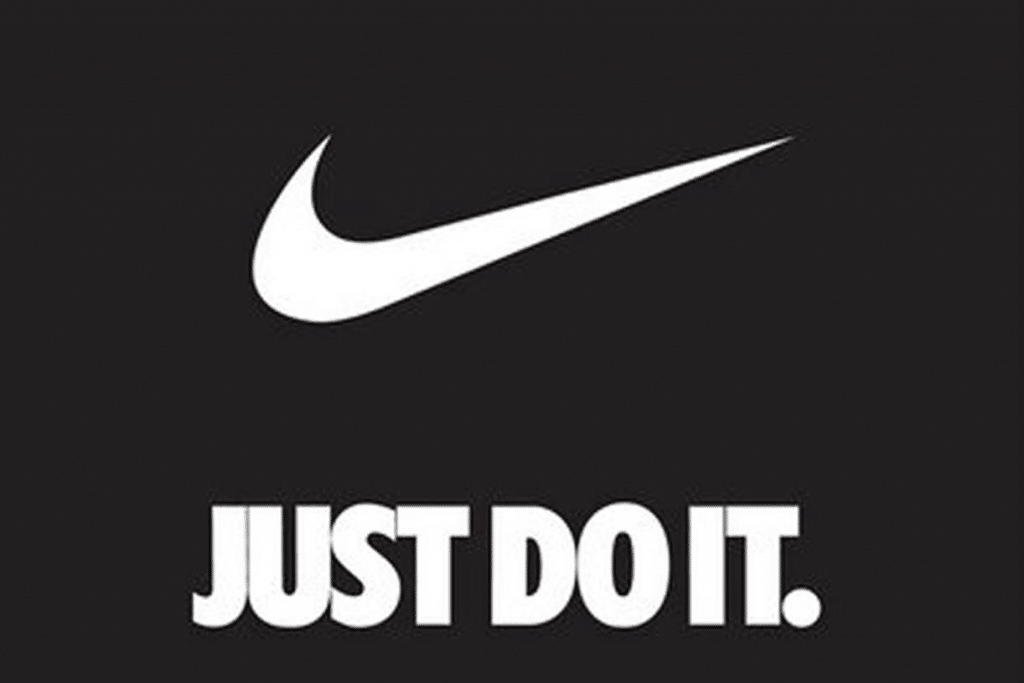
The entire brand strategy revolves around this line. It works because “Just Do It” speaks to everyone: it’s a no-nonsense statement, whether you’re a casual gym-goer or a professional athlete. Nike credits their messaging strategy for helping them grow their sales worldwide by over $8 billion from 1988 to 1998.
2. Levenfeld Pearlstein
Industry: Legal
Location: Chicago
Messaging strategy: Create a huge holiday initiative to both help a community organization and differentiate the firm from other companies
Levenfeld Pearlstein, a Chicago-based law firm, won first place in the 2017 Legal Marketing Association’s messaging strategy awards category thanks to an inventive approach to greeting cards. During the holiday season, Levenfeld Pearlstein sent out lockboxes instead of the usual envelopes.
To open the lockbox, recipients watched a two-minute video about the Chicago Community Kitchen, which helps underemployed people find work in the food industry and provides meals for low-income individuals. The video explained the purpose of the Chicago Community Kitchen, and showed participants making chocolate bark. The unlock code for the box was given at the end of the video. Upon unlocking, viewers found the same chocolate bark that they had just watched being made.
By leveraging a unique mix of old-fashioned tech and digitalization, this move went above and beyond the usual holiday greeting, and resulted in a huge burst of donations for the Chicago Community Kitchen. With this strategy, Levenfeld Pearlstein greatly benefitted an important community organization and created holiday goodwill all around.
3. Pharmacy2U
Industry: Healthcare
Location: The United Kingdom
Messaging strategy: Introduce a new communication tool to better interact with and serve patients
Pharmacy2U is an online pharmacy based in the UK. Through a partnership with Britain’s National Health Service, Pharmacy2U delivers repeat prescriptions to homes of hundreds of thousands of customers.
As of 2018, they were adding roughly 7,000 new customers per week. As a fully internet-based company, Pharmacy2U needed to show that they were able to keep up clear communications and a high degree of customer service.
To do that, they decided to use RingCentral Contact Centre™, an omnichannel customer service solution that lets customers choose their preferred method of communication, whether that’s voice, chat, SMS, or email. The platform comes with self-service options to help patients connect with the best possible advisor and includes tools to optimize Pharmacy2U’s staff scheduling and call centre efficiencies.
A messaging strategy isn’t just about the text and copy used—it’s also how a company chooses to communicate with their customers. By streamlining communications, Pharmacy2U showed patients that they care about having a fully customer-centric business, and they’ve seen an 80% increase in prescriptions filled from 2018 to 2019.
4. PayPal
Industry: Financial technology
Location: Worldwide
Messaging strategy: Differentiate themselves from their former parent company (and other payment companies) by highlighting innovation
In 2015, it was announced that PayPal would split off from their parent company, eBay. Eager to differentiate themselves from their former owner, PayPal launched their “New Money” campaign in 2016, premiering their first-ever TV ad during Superbowl 50:
“New Money” showcased PayPal’s messaging strategy: that their payment method is unhindered by time zones or technological restrictions. PayPal is all about being forward-thinking and leaving limitations behind. “New Money” is inclusive and available to all, in contrast to “old money,” which is portrayed in the ad as archaic and out of touch.
“New Money” was well-received and helped PayPal distinguish themselves as a key player in finance. As of 2019, PayPal sits at number 204 on the Fortune 500.
How to create your own messaging strategy in 5 steps
So, you’ve got your four essential elements of a messaging strategy, and you can see the importance of it. But pulling one together is still a big task. Don’t worry—here’s a step-by-step guide to creating your own messaging strategy.
1. Create a guide
Your messaging strategy needs to be outlined in a guide. This guide should contain your unique selling point, your company goals, information about your target audience, and your company’s story. Slogans or taglines also go in here.
In addition, your guide should contain style instructions, such as tone of voice. Do you want to keep things positive in communications and avoid negativity as much as possible? Or maybe you want to name-check competitors and industry big fish to show that you can do it better. Collect ideas and let the best ones win.
Of course, once you’ve created your guide, it has to be easily accessible to you and your workforce. Otherwise, it won’t be used. Apps like RingCentral are built for file sharing and collaboration. Your guide will evolve as time goes on, so your team needs to be able to read it, comment on it, and edit it whenever it needs to be updated:
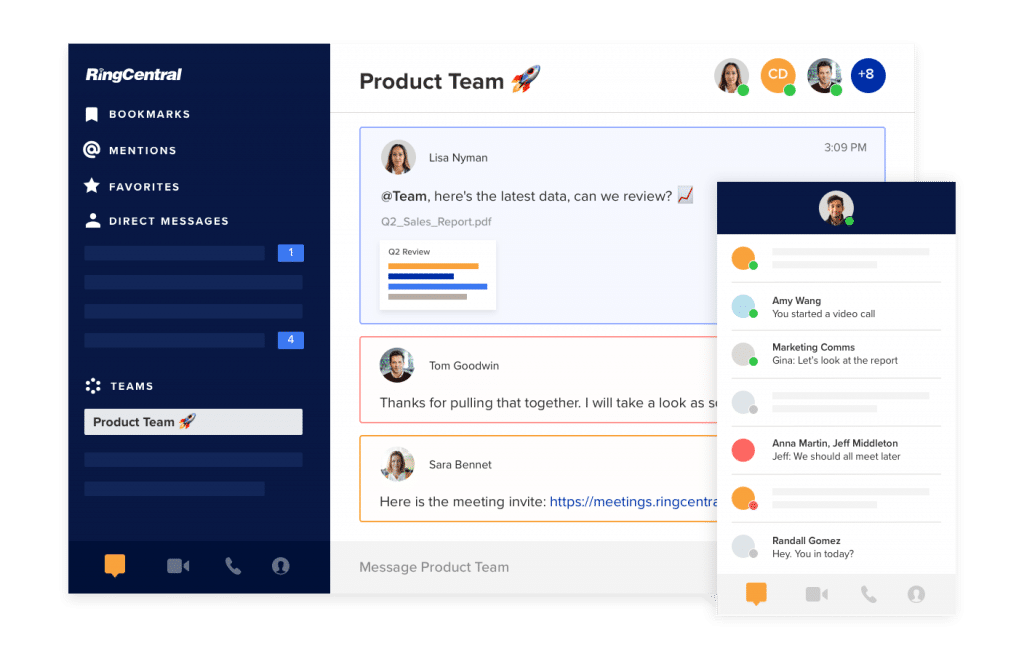
2. Manage your messaging channels
It’s 2020, so there’s a dizzying amount of digital channels and tools in marketing stacks out there. Marketing emails are a favorite of businesses, but they shouldn’t be your only way to communicate directly with customers. If you’ve got a Facebook page, Instagram account, or Twitter account, you’ll be interacting with customers across all of these.
With RingCentral Engage Digital™, you can combine messages from all digital channels, from those mentioned above to Apple Business Chat, WeChat, in-app messaging, and more. It even lets you merge customer identities from multiple platforms into a single profile to help you personalize your customer’s experience even further.
If you’re using SMS to talk to customers, RingCentral’s Business SMS can also help you to manage communications by enabling you to text seamlessly across your smartphone, tablet, desktop, or Apple Watch. Automated text messages are another great way to reflect your brand’s personality—reminder texts are important, and you know your customers are going to read them.
3. Think about each communication before you send it
We’re constantly being deluged by information and unwanted communications, so before you send your customers anything, think about it from their point of view. Ask yourself: as a customer, is this something I want to read? What do I gain from it?
If you have a hard time answering those questions, then you may need to rethink the content you’re about to send. Communications should always have a purpose, whether it’s offering news or deals or something else, instead of just being a reminder that your business exists. Nobody likes spam.
4. Continuously research your target audience
Every interaction is a chance to find out more about your customers. There are tons of tools available for this. While Google Analytics and Facebook’s Audience Insights tools can inform you about your customers on each platform, RingCentral Engage Digital can track your performance across channels to give you the complete picture.
Remember that tailoring communications for different groups can be effective, too. As time goes on, your target audience may change or diversify. This isn’t a bad thing, but your messaging needs to keep up—generic messages won’t always be suitable.
5. Don’t be afraid of feedback
Work with your team to continuously improve your messaging strategy, and listen to them as well as your customers. Not everything will work—sometimes an ad or a sign may strike a nerve, an email won’t get replies, or a campaign will fall flat.
So, don’t be too hard on yourself. Critical feedback is just another chance to refine your messaging strategy and make it more effective. How you receive and implement feedback also says something about your brand, so it’s another way to show your customers what sets you apart from the rest.
Know yourself, and know your messaging strategy
A well-crafted messaging strategy should be a foundation of your business. Define your goals and get your message out there – a compelling story, coupled with the right tools to tell it, will resonate with customers and make a world of difference for you and your brand.
Originally published Mar 02, 2020, updated Nov 17, 2021


